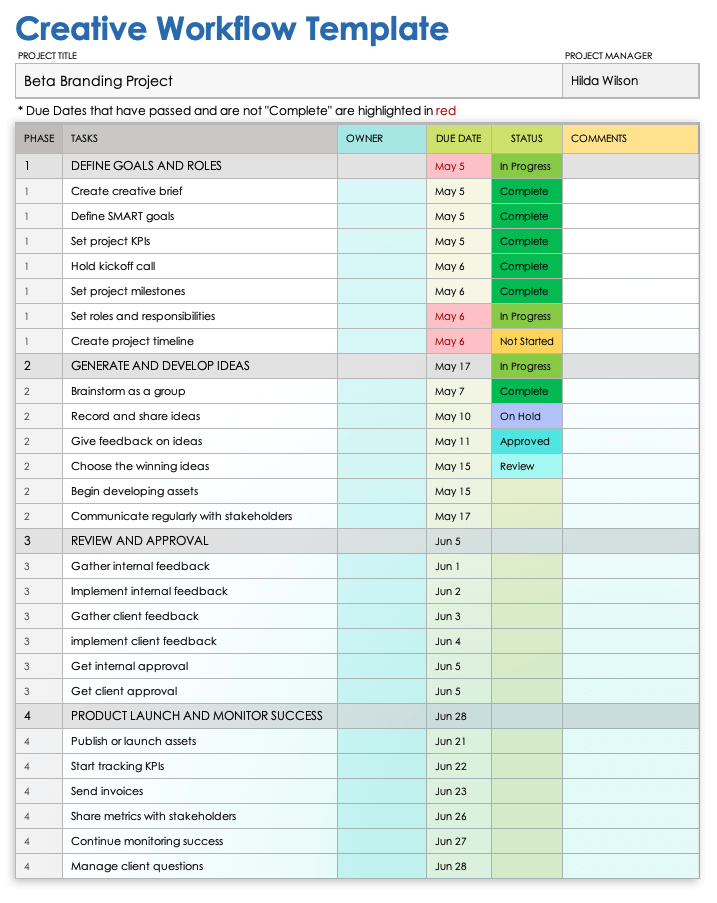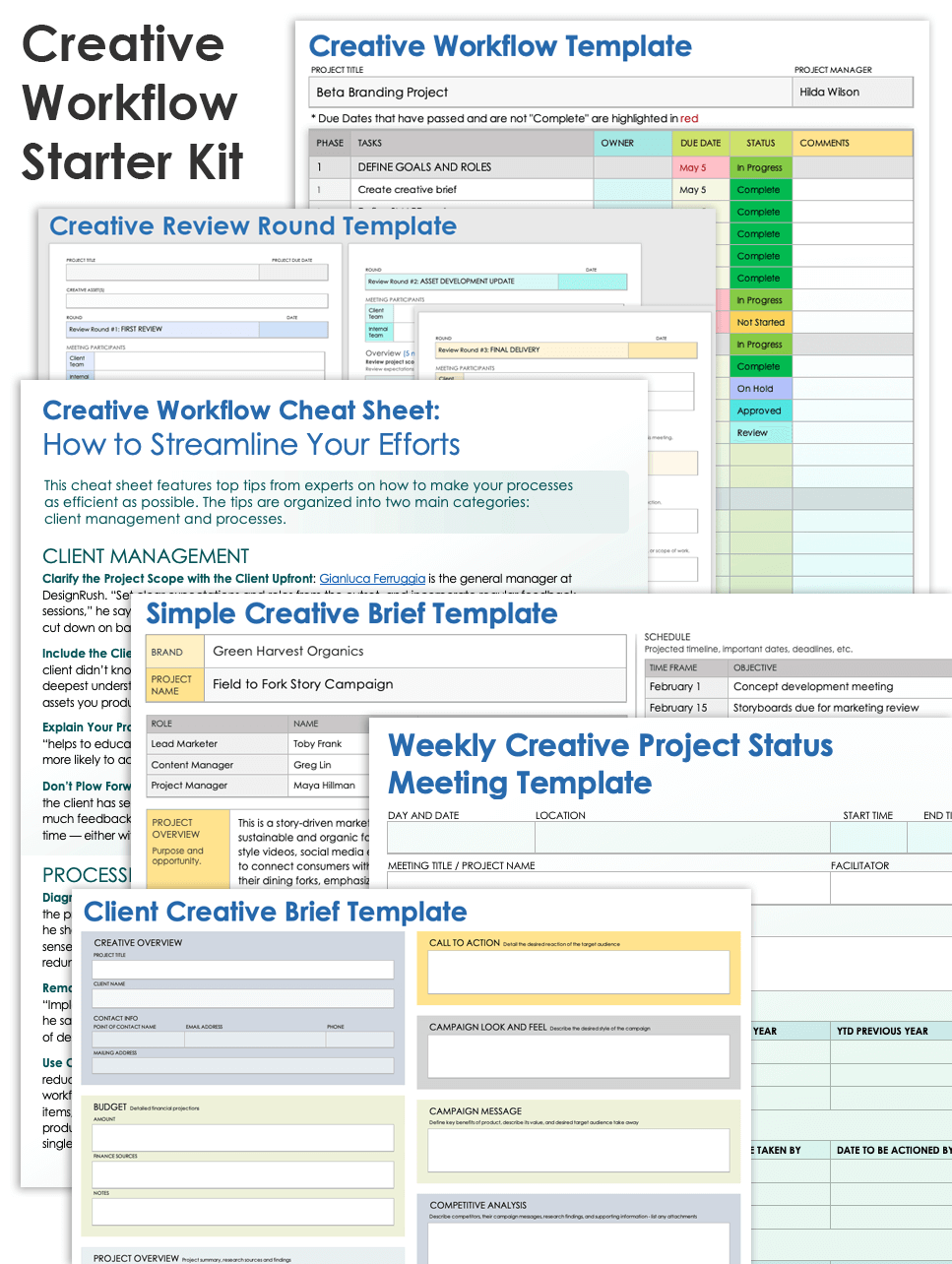What Is Creative Workflow Management?
Creative workflow management refers to the way a team or organization oversees the process of developing creative assets, from idea generation to design approval to project launch. The best creative workflows are an ordered, repeatable sequence of tasks.
Creative workflow management is a part of overall creative operations, which refers to the way a company manages the internal creative process. Creative agencies need to have strong workflows and processes in place in order to meet their clients’ expectations in terms of quality, budget, and timeline. The same goes for internal creative teams that produce creative assets for their own organization. Learn more in this step-by-step guide to creative operations.
Each of the following disciplines requires creative workflow management that differs in key ways:
- Creative Agency Workflows: This refers to the specific processes a creative agency follows to complete their work. In this context, workflows are repeatable methods team members use to perform their roles, focusing on general operations rather than specific projects or deliverables. However, these methods influence the development of individual creative assets, including advertisements, design elements, and other creative materials. Find out more in this post on creative agency process workflows.
- Creative Team Workflows: This describes the processes creative teams use to manage their end-to-end operations within their department and across projects. Each team member — including copywriters, designers, video producers, editors, strategists, and creative directors — contributes unique skills. The efficiency of the creative team’s workflow depends on each member clearly understanding their roles and responsibilities, which may vary slightly from one project to the next. Improve your management skills with this guide to managing creative teams.
- Creative Project Management: Creative project management involves overseeing the successful delivery of creative assets and includes all typical phases of the project management lifecycle: project initiation, planning, execution, monitoring and control, and project closeout. Ensure your next project is a success by reviewing this article on effective creative project management.
You may also hear the terms creative production workflow, creative series workflow, or creative studio workflow processes. These terms all refer to the repeatable processes you use to manage a creative project or asset from start to finish.
Learn how to move your creative projects through the project lifecycle in this article on reshaping your creative workflows, as well as this comprehensive guide to digital asset management (DAM) workflows.
The Phases of Creative Workflow
There are four phases in all creative workflows: defining goals, generating and developing ideas, reviewing and obtaining approval, and launching projects and monitoring success. Establishing a repeatable workflow will streamline your process, eliminating the need to reinvent the wheel each time.
Below, you’ll find details about each phase, as well as a creative workflow template you can use to manage your creative projects.
Phase One: Define Goals and Roles
In the first phase, define the goals of the project. Use one of these creative brief templates to ensure you capture all necessary information, including stakeholders, budget, timeline, goals, objectives, and more. When defining goals, make sure they are specific, measurable, achievable, relevant, and time-bound (SMART). Try using one of these SMART goal worksheets and examples to get started.
From there, hold a kickoff meeting with all relevant stakeholders (including the client for external projects). In this meeting, introduce the team members, review the information in the creative brief, discuss how the project’s success will be measured, and explain the team reporting structure. The goal of the kickoff meeting is to align all stakeholders on the project goals and constraints.
Next, start developing project milestones by segmenting the project into related task groups. For example, finalizing a cover image or producing all animation elements for a video. At this stage, you might also place these milestones on a preliminary timeline.
Then, assign roles and responsibilities within the creative team. Common roles include project owner, strategist, project manager, designer, copywriter, and developer, though additional roles may be required depending on the project. Outline the team hierarchy and clarify who will handle which aspects of development, approval, and completion of the project. Define the approval process, specifying when, how, and by whom each round of approval will occur. Clearly identify who will review each project phase and provide feedback, and specify deadlines for these inputs and approvals. Aim to limit the number of reviewers and review rounds. Establish a naming convention for revisions to ensure everyone knows which draft is the most current.
Phase Two: Generate and Develop Ideas
Phase two is where all the creative ideation takes place. Start with brainstorming. You can engage in traditional brainstorming by gathering as a group and jotting down all ideas on a whiteboard. Another option is to try modern variations such as mind mapping (where the team collaborates to visually solve a challenge) or reverse brainstorming (where you begin with the final product and work backwards).
Hillary Kelbick, President and Chief Executive Officer of MKP Communications, says the original brainstorming meeting is crucial. It’s also important to keep the tone of the meeting to strictly brainstorming. “At this point, there are no bad ideas,” she advises. “The rule is we write everything down — even if it sounds stupid. Throw everything you’ve got against the wall. There’s nothing silly at this point because you don’t know where the creative energy is going to come from. Embrace everything.”
You can learn more about brainstorming techniques by reading our guide to motivational brainstorming approaches.
Once you’ve generated a range of ideas as a group, review them together and provide feedback. Encourage all team members to share their thoughts to create an environment where everyone feels comfortable contributing. Doing this will allow the team to pinpoint the breakthrough idea.
After selecting the best ideas, begin developing them. Many creative projects require diverse types of content, including videos, static images, written articles, podcasts, social media posts, and memes. If you are working for a client at a creative agency, ensure you hold periodic check-in meetings to gain their approval on the direction. These intermittent approval sessions will help prevent dissatisfaction at the final delivery.
Kat Yowell, a Senior Designer with Lucid Agency, a digital marketing agency with offices in Phoenix and Chicago, says her team may share some written content or a design idea with the client in the early stages. In building a website, for example, the team will likely share wireframes of a potential website or web page — a design showing what elements and interface elements will exist on important pages. The team may also share a more fully developed interior web page to give the client “an idea of how that’s going to feel before we launch into the rest.”
The idea is just to check in with the client, to “[make] sure we’re on the right path,” Yowell adds.
Depending on the type of project or campaign you’re working on, consider repurposing the same content across different media types — for example, presenting the same lesson in a video, a written how-to article, and an Instagram slide post.
During the development process, adhere to the timeline established in the project kickoff. Communicate promptly if issues arise and share status reports both internally and externally to ensure everyone is aligned. Also, consider using online project management or workflow tools to facilitate this process.
If you’re working with a client, err on the side of over-communication.
Phase Three: Review and Get Approval
At this stage, you need both internal and external sign-off on the creative assets you’ve developed. There will likely be multiple review rounds. Optimizing these rounds is crucial to moving efficiently toward launch.
Start with internal approval. Include the entire creative team, your direct management, and any other internal stakeholders. Gather feedback on the initial designs and builds, and refine them until a consensus is reached.
If you’re creating work for an external client, you can now initiate review rounds with them. Share content with your client remotely by sending them the creative files and reviewing them together over a video call, or in person if possible.
It’s important to structure your review cycles in advance to ensure they are efficient and you are clear on the type of feedback you are seeking. Create an agenda for the meetings, and set a limit on the number of review rounds allowed under the current contract. (The industry standard is three.) In the starter kit below, you’ll find a free review round meeting agenda template, which you can use to conduct three rounds of reviews and obtain final approval.
You can also capture feedback with a live note-taking or design review software that allows comments to be left directly on the designs. Ensure that everyone has access to the same versions to avoid redundancy and version control issues. This approach also helps centralize all feedback, saving time when making updates in subsequent rounds.
Once you receive your client’s approval (whether an internal team or a higher-up), formalize it. Obtain any necessary approval signatures and proceed to prepare the content for publication.
Phase Four: Product Launch and Monitor Success
The final and most exciting phase is the product launch, which typically means distributing print materials, releasing a video, or posting digital materials online. After launch, however, you’ll still have a couple of steps to complete.
Upon launch, begin tracking metrics to gauge the success of the content. You should have defined KPIs during the initial phase, so start with those. In addition, document metrics about how the project unfolded, such as the number of assets created, the number of versions and review rounds conducted, the time taken to obtain approvals, and the overall duration of the project lifecycle.
Continue monitoring these KPIs for the duration and frequency outlined in your creative brief. Make sure to share these metrics with your client as well. If the results are not satisfactory, consider further refining the assets, especially for long-term campaigns.
After the launch, you’ll also need to send the final invoice to your client and conduct a project post-mortem. Use this opportunity to gather their feedback on the overall project execution and areas for improvement. These discussions are crucial for maintaining and strengthening your client relationship and ensuring continued collaboration.
Creative Workflow Template
Download a Creative Workflow Template for
Microsoft Excel
|
Microsoft Word
| Google Sheets
Use this creative workflow template to track the progress of your creative project from start to finish. The template organizes the project into four phases, complete with sub-tasks, providing a robust, repeatable structure for you to follow. While you can customize the template to suit your needs, it comes pre-built with sections for listing the task owner, due date, status, and additional notes.
Best Practices to Set Up an Effective Creative Workflow Process
To set up an effective creative workflow, experts recommend that you clarify scope, diagram the workflow, use workflow software, hold regular check-in meetings, and measure workflow effectiveness. Also, make sure that team members can actually follow your workflow.
Below are some important overall workflow process steps to include:
Clarify Scope, Objective(s), and Strategy With the Client
At the start of any project, formally clarify the project objectives and the basic plan to achieve those objectives — preferably through a written document that everyone approves.
“When we get an assignment, the project manager has to clarify with the client exactly what has to be communicated — and the important objectives of that communication,” explains Kelbick.
Kelbick says her firm prepares a strategy statement for the project, which she says “is presented and reviewed by the client — so everyone is on the same page about what it is that we’re communicating.”
Diagram Your Workflow
For each specific project, it’s helpful to create a diagram or chart that shows the phases in the process, as well as the approvals, inputs, and other actions needed. Pay attention to the mutually exclusive, collectively exhaustive (MECE) principle developed by business consulting firm McKinsey & Company. In essence, you should group categories of information so that they don’t overlap and that your assessment includes all possible categories. In the context of creative workflow, MECE means that there should be no confusion about the requirements and who’s responsible for them in each phase, and the workflow covers every aspect of the project from beginning to completion.
Ed Burgoyne, Founder and Lead Advisor of Makr Consulting, helps organizations perform a broader assessment of how their workflow process works in general — outside of any specific project.
“Sometimes the process of just getting together and looking at how things currently work is eye-opening for people,” he shares. He says the process helps organizations ask themselves: “How do we do what we do? Why do we do it that way? Does that make sense? How do we describe what we do?”
Get Team Agreement on the Workflow Process
It’s vital that everyone understands and agrees with the structure and details of your workflow process at the outset. When Burgoyne works with organizations to help them understand and improve their work processes, he stresses the importance of common agreement. “We can create process maps all day long,” he says, “but behavior is super, super important. How do we act? We have to manage change processes with behavior in mind. I can recommend processes all day long and put it on a wall, but unless people are going to follow it, they won’t get the results they desire.”
That’s why Burgoyne suggests organizations work with their entire team to collaborate on how to structure their work processes — doing so allows for buy-in from everyone from the beginning.
Use Creative Workflow/Project Management Software
While some organizations can implement and follow a creative workflow process without software, many experts believe the software can be extremely helpful in tracking the processes and avoiding confusion.
An organization can use software to integrate all written communications within the software, integrate calendar items and reminders, and make it much easier and more efficient to monitor and approve tasks for the project and review the work.
Have Check-in Meetings
Even when you’re using software and other digital communications vehicles, it’s helpful to have periodic check-in meetings with the team to ensure the project is moving forward and on schedule.
Creative Workflow During Phases of a Project
Your team should also keep in mind the following important points during various phases of the project.
Project Outset
Use a formal project request process and make sure your internal team follows it.
“One of the biggest pillars is that initial request process,” says Brian Bosche, a Senior Product Manager at Smartsheet and the founder and former CEO of Slope, a company that developed software to help with creative workflow and is now a part of Smartsheet. “It’s really important people know where they should go to submit a request. Having the process of intake is really important.”
The intake process ensures that everyone understands all projects that are set to start and gives everyone the required information at the beginning, Bosche adds.
Project Development
Track the amount of work needed for various tasks within the project, balance the workload when possible, and make sure the schedule accounts for certain team members with large workloads.
Yowell of Lucid Agency says her organization has weekly meetings to assess what each designer or other team member is working on. The agency uses software to assign between one and three points to each task, based on how long the task is likely to take. “[Doing so] gives us a birds-eye view with tasks laid out; with that number system, we can figure out how we can shuffle tasks if needed,” she explains.
Client Review and Approval
Communicate to clients how the review process works best (including deadlines), and be aware of any client-caused delays that might occur.
How to Manage a Creative Workflow
Managing a creative workflow requires a solid workflow system within your organization, team members who understand the importance of following efficient processes, and managers who are adept at overseeing and tracking the work. SaaS tools can also be useful for tracking and managing the creative workflow process.
Download the Creative Workflow Starter Kit
If you’ve never created standard processes for managing your creative teams, it can be daunting. This free starter kit provides all the resources you need to get started. It will help you get organized, document your workflows, clarify all the creative assets you need to create, and manage approval rounds, whether you’re working for an external client or your own organization.
Download the Creative Workflow Starter Kit
In this kit, you’ll find the following:
- A creative workflow template for Excel and Microsoft Word that includes all the common phases and sub-tasks associated with the end-to-end workflow.
- A client creative brief template for Excel to capture requirements for any creative assets you’re creating for an external client.
- A simple creative brief template for Microsoft Word to document the specs for a simple internal creative project.
- A weekly creative project status meeting template for Excel and Microsoft Word to streamline and simplify check-in meetings.
- A creative review round template for Microsoft Word to structure your internal or external creative asset review meetings, with space for three rounds of review meetings and signature lines for final approvals.
- A creative workflow cheat sheet for Microsoft Word with top tips from experts on how to make your creative workflow as efficient as possible.
Biggest Mistakes in Managing Creative Workflow
Experts within and outside of agencies say organizations often make common mistakes in structuring or managing creative workflow. Here are some of the most common mistakes:
- Discounting the client’s potential contribution to the design work. “Early in my career, my biggest mistake was thinking the client [didn’t] know anything,” shares Yowell. She adds that she would think, “‘How dare you come back with changes — you don’t know what you’re talking about.’ That’s wrong.” The client understands its company’s personality, and the tenor of the industry it’s in, she says. It understands, for instance, that an edgy website design might not work for an engineering company.
- Not engaging in periodic touchpoints on the original and developing the overall direction of the design. “Coming in with a bunch of (web) pages designed before the client has seen even one design can backfire hugely,” Yowell says.
- Building a creative workflow process from the perspectives of only some players, and not including viewpoints from everyone. Burgoyne explains that project managers or other agency leaders may structure a workflow process that makes sense to them, but may fail to include important considerations from others who do the work every day. “When you look at a process and develop a process, we really need to collaborate with the people involved with the process itself to make a process that actually works,” he says. “It’s really important to look at the process from a systems perspective and see how all the different pieces come together.”
That inclusiveness is also vital when the new process structure means significant changes in how the organization does its work. “People can be very averse to change that they’re not involved with,” Burgoyne advises.
Advice on Creative Workflow and Building Cross-Functional Teams
Burgoyne, of Makr Consulting, says creative agencies and organizations must realize that their workflow process and management is vital to the identity of their organization.
“It’s about how do you actually do problem-solving and how you look at the world. What’s a priority and what’s not a priority?” he explains. “Your process is a big part of who you are. [And] the process determines the quality of our product and the quality of our output.”
Burgoyne writes about creative workflow processes on his professional blog, Adsubculture. He cites several areas that are helpful to understand in improving creative workflow. They include the following:
- Understanding traditional project management frameworks
- Understanding how to build cross-functional teams with members from different departments working together
- Understanding the structure and organization of advertising agencies
- Understanding various structures of creative production and services workflow
- Understanding how project management methodologies like Waterfall and Agile can help in creative workflow
Learn more about these methodologies in this guide to Agile project management and this article on when to use the Waterfall methodology.
How to Deal with Clients Who Want to Change Your Creative Workflow Process
A client will sometimes want to change some aspect of a project that can significantly alter your workflow process. They are your client, of course, so sometimes you will need to accommodate their requests. However, sometimes accommodating suggested changes can impair the process and diminish the final product. In those scenarios, you may need to push back a bit against the client’s request — politely and with a good explanation, of course.

Jim Hamilton is a content and copywriting expert and founder of Persuasive Alchemy, a newsletter and community for consultants. “If a client wants to change your existing creative workflow process, it’s usually because they’re unsure about how the process is going to unfold, or because they lack confidence in your ability to deliver,” he says. “Either way, the best way to overcome this is to walk them through your process step-by-step at the beginning of the project. Make it clear where and when they’ll have an opportunity to weigh in throughout. But reiterate that your process is what allows you to meet the high standard of quality all of your clients expect from you.”
Here are some other top tips of how to manage clients who want to change your processes:
- Be Polite: Always try to understand the client’s point of view before responding too quickly. Try to be calm, understanding, and polite in explaining the importance of your process setup.
- Don’t Waver: Don’t surrender too easily if your client is insistent on changes that you know will hurt the project. Explain the structure of your process and how that helps their product in the end.
- Offer Alternatives: Try to get a sense of their underlying concerns in making the change request. Then offer alternatives that might address those concerns, without changing your workflow process.
- Explain Your Processes: Ferruggia of DesignRush says, “It helps to educate [your clients] about your process and how it benefits the project outcome.” They will be much more likely to accept your way of doing things if they understand the intention and expected benefit.
- Remain Open to Their Ideas: As the age-old adage goes, the customer is always right. While you want to maintain the structure that allows you to accomplish your work, it helps to remain flexible. “Start by understanding their specific needs and expectations, and then strategize on how best to incorporate their feedback without hampering the workflow,” says Naydenov. “Flexibility is key, but maintaining the core process that works for your team is equally important.”
Ferruggia echoes this idea. “Being open to valuable input can sometimes lead to constructive adaptations,” he says.
More generally, both Ferruggia and Naydonev stress the importance of understanding your client’s needs and intentionally managing that relationship.
“Managing client expectations starts with setting clear, realistic timelines upfront, maintaining open lines of communication and updating them routinely on project advancements,” says Ferruggia. “It’s equally important to understand the client's vision thoroughly to ensure the final product aligns with their expectations.”
“My top tips for managing clients' expectations in a creative project include setting clear communication protocols and ensuring complete transparency in project advancement,” says Naydonev. “It's pivotal to provide regular updates to keep them informed and manage their expectations.”
Creative Workflow Automation
Creative workflow automation refers to the software an organization uses to streamline repetitive tasks within a creative process. Automation can save you time and reduce manual or tedious tasks so you can devote more time to the creative work itself.
Automation is a broad term that can encompass a variety of specific functions. Many creative teams use automation to do the following:
- Centralize Creative Assets: Store, track, and manage all creative assets in a centralized, cloud-based solution, allowing team members to access them from anywhere at any time.
- Facilitate Direct Feedback: Provide feedback directly on designs, eliminating concerns about version control issues.
- Automate Notifications: Set up automated notifications and alerts for changes in status to ensure everyone is up to date.
- Monitor Timelines and Budgets: Track timelines and budgets in real time to maintain control over the project’s progress and finances.
- Utilize Project Templates: Create master project plan templates to streamline setup and avoid redundancy with each new project.
- Distribute Essential Files: Distribute files to the appropriate team members to maintain workflow efficiency.
- Route for Approvals: Route files through the necessary channels for approval to ensure quality and compliance.
“To me, creative workflow automation is about utilizing digital solutions to enhance productivity and minimize manual tasks, which has led to more efficient resource allocation and better project timelines,” says Naydonev of Businessmap. “The benefits are manifold, including increased accountability, improved task prioritization, and overall time-saving.”
Learn more in this guide to the benefits of workflow automation.
Why You Need a Good Creative Workflow Process
Any organization that does creative work has deliverables and deadlines. Those deliverables — the creative work itself — and its deadlines can be continually disrupted when there isn’t a process for starting, developing, and approving the work. Everyone involved needs to understand the project’s details, what it needs to move forward, who has and hasn’t offered input, and whether it’s on track to be delivered on time.
Having a creative workflow process that tracks and steers all of the work can help avoid confusion, and also saves time and money. Organizations that routinely implement creative workflow processes include graphic design firms, advertising agencies and digital creative agencies (sometimes called simply digital agencies). But many other organizations also implement the process to become more efficient. Some organizations have implemented a creative workflow process that is more old-school — one limited to emails, spreadsheets, meetings, and continual communication. Others use software or software-as-a-service (SaaS) solutions to help manage workflow.
Build Powerful Creative Workflows with Real-Time Work Management in Smartsheet
The best marketing teams know the importance of effective campaign management, consistent creative operations, and powerful event logistics -- and Smartsheet helps you deliver on all three so you can be more effective and achieve more.
The Smartsheet platform makes it easy to plan, capture, manage, and report on work from anywhere, helping your team be more effective and get more done. Report on key metrics and get real-time visibility into work as it happens with roll-up reports, dashboards, and automated workflows built to keep your team connected and informed.
When teams have clarity into the work getting done, there’s no telling how much more they can accomplish in the same amount of time. Try Smartsheet for free, today.








